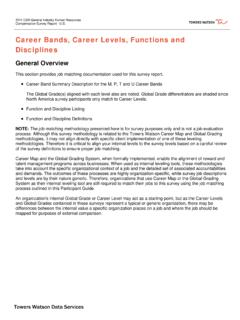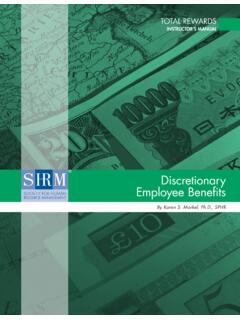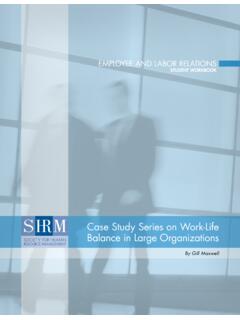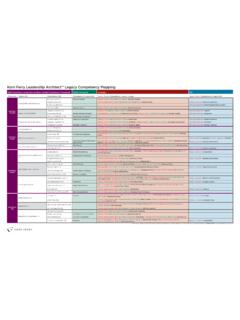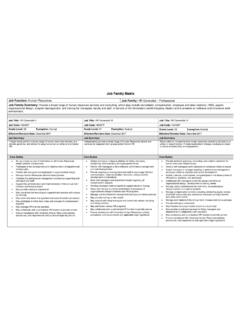Transcription of SHRM Body of Applied Skills and Knowledge
1 SHRM Body of Applied Skills and KnowledgeYour Comprehensive Roadmap for a Career in HR202211 Table of Contents2022 SHRM Body of Applied Skills and Knowledge 3 SHRM Body of Applied Skills and Knowledge : SHRM BASK Graphic 4 What Are Competencies? 5 Knowledge + Behavior = Success 5 Development of the SHRM BASK 6 New Material in the 2022 SHRM BASK 8 Organization of the SHRM BASK 9 leadership Cluster 11 leadership & Navigation 12 Navigating the Organization 13 Vision 14 Managing HR Initiatives 15 Influence 16 Ethical Practice 17 Personal Integrity 18 Professional Integrity 19 Ethical Agent 20 Diversity, Equity & Inclusion 21 Creating a Diverse and Inclusive Culture 22 Ensuring Equity Effectiveness 23 Connecting DE&I to Organizational Performance 24 Interpersonal Cluster 25 Relationship Management 26 Networking 27 Relationship Building 28 Teamwork 29 Negotiation 30 Conflict Management 31 Communication 32 Delivering Messages 33 Exchanging Organizational Information 34 Listening 35 Global Mindset 36 Operating in a Culturally Diverse Workplace 37 Operating in a Global Environment 38 Advocating for a Culturally Diverse and Inclusive Workplace 39 Business Cluster 40 Business acumen 41
2 Business and Competitive Awareness 42 Business Analysis 43 Strategic Alignment 44 Consultation 45 Evaluating Business Challenges 46 Designing HR Solutions 47 Advising on HR Solutions 48 Change Management 49 Service Excellence 50 Analytical Aptitude 51 Data Advocate 52 Data Gathering 53 Data Analysis 54 Evidence-Based Decision-Making 55 People Knowledge Domain 56HR Strategy 57 Talent Acquisition 59 Employee Engagement & Retention 61 Learning & Development 63 Total Rewards 65 Organization Knowledge Domain 67 Structure of the HR Function 68 Organizational Effectiveness & Development 70 Workforce Management 71 Employee & Labor Relations 73 Technology Management 75 Workplace Knowledge Domain 77 Managing a Global Workforce 78 Risk Management 80 Corporate Social Responsibility Employment Law & Regulations 84 Appendix A: Glossary 86 Appendix B: Resources 1012 SHRM BODY OF Applied Skills AND KNOWLEDGE2022 SHRM BODY OF Applied Skills AND KNOWLEDGE2022 SHRM Body of Applied Skills and KnowledgeFor more than 70 years, the Society for Human Resource Management (SHRM) has served the human resources (HR) profession.
3 HR professionals worldwide look to SHRM for comprehensive information and tools to help them effectively perform their jobs, develop their careers and transform their organizations. Together with SHRM, these HR professionals create better workplaces where employers and employees thrive together. In 2011, SHRM began a program of research involving thousands of HR professionals to identify the critical competencies needed for success as an HR professional. This research led to the development of the initial SHRM Competency Model, which defined eight key behavioral competencies ( leadership & Navigation; Ethical Practice; Relationship Management; Communication; Global & Cultural Effectiveness; Business acumen ; Consultation; and Critical Evaluation) and one technical competency (HR Expertise). The SHRM Competency Model represented an important advance for the field of HR by focusing on the types of behaviors that are integral for success in SHRM Body of Applied Skills and Knowledge (SHRM BASK ), formerly the SHRM Body of Competency and Knowledge (SHRM BoCK ), represents the evolution of the SHRM Competency Model by further defining the Knowledge areas in addition to the behavioral competencies.
4 The SHRM BASK was developed through a series of large-scale research studies that incorporated the viewpoints of thousands of HR professionals from around the world. It was most recently updated in 2021, and now includes nine behavioral competencies as well as one technical addition to describing the HR field, the SHRM BASK is used to define the content areas of SHRM s certification examinations: the SHRM Certified Professional (SHRM-CP ) exam for HR professionals in operational roles and the SHRM Senior Certified Professional (SHRM-SCP ) exam for senior-level HR professionals in strategic roles. The two SHRM credentials provide reliable indicators to the global business community that the credential-holder is a recognized expert and leader in the HR field with the necessary capabilities in both aspects of HR practice competencies and Knowledge that are required for effective job , the SHRM BASK is also the common framework for the item writers who develop SHRM-CP and SHRM-SCP exam questions, as well as individuals and organizations developing exam preparation materials.
5 SHRM s own operations for exam development are separate and independent from its operations for study material development. SHRM observes a strict firewall between these activities to protect the integrity and credibility of the certification BODY OF Applied Skills AND KNOWLEDGE2022 SHRM BODY OF Applied Skills AND KNOWLEDGESHRM Body of Applied Skills and Knowledge : SHRM BASK GraphicDIVERSITY, EQUITY& INCLUSIONETHICALPRACTICEBUSINESSACUMENRE LATIONSHIP MANAGEMENTGLOBALMINDSETWORKPLACEPEOPLEOR GANIZATIONLEADERSHIP &NAVIGATIONANALYTICALAPTITUDECONSULTATIO NCOMMUNICATIONLEADERSHIPBUSINESSINTERPER SONAL4 SHRM BODY OF Applied Skills AND KNOWLEDGE2022 SHRM BODY OF Applied Skills AND KNOWLEDGEWhat Are Competencies?A competency is a group of highly interrelated Knowledge , Skills , abilities and other characteristics (KSAOs) that give rise to the behaviors needed to perform a given job effectively. For example, Analytical Aptitude, one of the behavioral competencies in the SHRM Competency Model, describes a group of KSAOs that include Knowledge of research design, critical thinking Skills and deductive reasoning abilities.
6 These KSAOs enable HR professionals to collect, compile, analyze and interpret job-relevant data and information to support the HR function in their competency model is a set of competencies that collectively defines the requirements for effective performance in a specific job, profession or organization. Competencies can be either technical or behavioral. Technical competencies reflect the Knowledge specific to a given profession that is required for a professional in that field to perform a particular role. The HR Expertise competency in the SHRM Competency Model describes the technical Knowledge specific to the HR field (such as talent management, recruiting, or compensation and benefits).Behavioral competencies, on the other hand, describe the KSAOs that facilitate Knowledge to job-related behaviors. They are more general in their applicability than the profession-specific technical competency of HR Expertise.
7 For example, the behavioral competency Communication describes the KSAOs needed to effectively communicate across a range of media (such as e-mail and oral presentations) and with a variety of audiences (including internal and external stakeholders).In sum, technical competencies reflect what Knowledge HR professionals apply on the job, and behavioral competencies reflect how they apply this + Behavior = SuccessSHRM s incorporation of behavioral and technical competencies into its competency model and certification exams implicitly recognizes that a strategic mindset leading to HR success is a function of the successful application of both Knowledge and behavior. In other words, success stems not only from what you know ( Knowledge ) but also what you do (behavior). Neither is sufficient in s dual approach to understanding HR success is supported by empirical research that was initially gathered in 2011-2012 to develop and validate the SHRM BoCK.
8 A study conducted by SHRM in partnership with several leading multinational employers and universities found that both HR Knowledge and behavior are related to HR professionals job performance. Moreover, it found that both Knowledge and behavior are uniquely related to job performance in nonredundant ways. These findings support the key contributions of Knowledge and behavior to HR success, the relevance and applicability of the SHRM Competency Model to the HR profession, and the relevance of certification exams that test both behavioral and technical BODY OF Applied Skills AND KNOWLEDGE2022 SHRM BODY OF Applied Skills AND KNOWLEDGED evelopment of the SHRM BASKSHRM engaged in a systematic and rigorous program of research to develop the SHRM BoCK. SHRM began this program with the development of the SHRM Competency Model in 2011, and it continued its effort through 2021 by conducting a series of activities to further refine the SHRM BoCK as well as validate research in the area of Diversity, Equity & Inclusion.
9 Comprehensive job analysis methods and the active engagement of the global HR community have been used consistently to identify, create and refine competencies that describe the attributes necessary for success as an HR initiated the development of the SHRM Competency Model in 2011 when it conducted 111 focus groups with nearly 1,200 HR practitioners, including professionals from 33 countries. Participants in these focus groups represented a diversity of characteristics, both personal (such as career level and tenure) and organizational (such as sector, industry and size). SHRM also conducted a survey of more than 600 chief human resource officers (CHROs) to identify the competencies that HR leaders believe are required for success in the HR profession. Following this extensive data collection, SHRM created a working competency model of eight behavioral competencies and one technical ( Knowledge -based) competency, which together describe the personal and professional attributes that HR professionals need for success and career 2012 to 2014, SHRM conducted a series of studies with HR professionals to confirm the content of the model and its relevance to success in the HR profession.
10 In 2012, SHRM conducted a survey of more than 32,000 HR professionals worldwide to confirm the importance and generalizability of the SHRM Competency Model. The results of this study support the relevance of the model in describing the personal and professional attributes needed for HR success, as well as its wide applicability. SHRM next conducted (also in 2012) a multiorganizational criterion validation study to measure the link between the competency model and job performance. The study involved a highly diverse sample of more than 800 HR professionals and their supervisors. The results of this study established that proficiency in the SHRM-defined competencies is closely linked to successful job 2014, SHRM conducted a Knowledge specification exercise to further develop the HR Expertise technical competency. First, SHRM performed an extensive review of the existing literature on HR Knowledge , including textbooks, curricula, syllabi and other educator resources, to determine the universe of potential areas of Knowledge that HR professionals need to perform their jobs.

